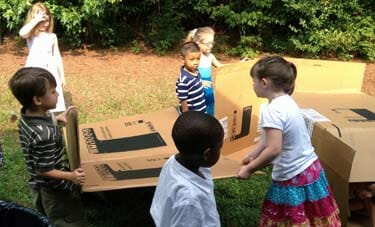They Taught Kids What it’s Like to Be Homeless – What Will You Teach Your Volunteers?
This post is by Thereasa Winnett, founder of Teach One Reach One.
Want volunteers who are more connected to your organization and the people you serve? One way is to develop a range of interactive experiences for volunteers to participate in before serving your organization.
 Thereasa Winnett
Thereasa WinnettOur church took a group of elementary school children and created an entire summer of activities to develop empathy for others. Many of these activities would work for teens and adults as well.
Perhaps one of the most meaningful was the week we dealt with homelessness. Outside the back of our building is a small grassy area that resembles the alley area behind many restaurants and shops. We placed large cardboard boxes and other types of things one might find in an alley around the area.
The children were introduced to the concept of being homeless in today’s world. They learned many homeless people are afraid of shelters for a variety of reasons and choose to stay on the streets.
We took the kids into our mock alley and instructed them to build some type of shelter. They struggled to create something that would protect them from the current high heat and humidity as well as the rainstorm they could see coming.
After completing the activity, we spent time discussing what they had experienced. We examined the emotions, fears and needs the homeless might have. After our discussion, the children were much more empathetic and connected as they worked on the service project we had planned.
 Children participate in an activity designed to teach them about homelessness.
Children participate in an activity designed to teach them about homelessness.Most likely your new volunteers have life experiences very different from the people they will serve. Plan or suggest activities requiring the volunteers to simulate aspects of this very different world. After the experience, have them share their insights.
How accurate are their realizations? Can they understand the emotions living in that manner every day would create? What would be their needs? What might volunteers do that they think is helpful, but actually makes things worse?
Taking a little extra time to prepare volunteers in more meaningful ways will prove extremely beneficial to any organization. Connected volunteers can save you time and money in your fundraising and volunteer recruitment efforts. Their service will be more effective and help you meet your program’s goals more easily.
Find tips, tools, lesson plans, activities and other resources on the Teach One Reach One website.
